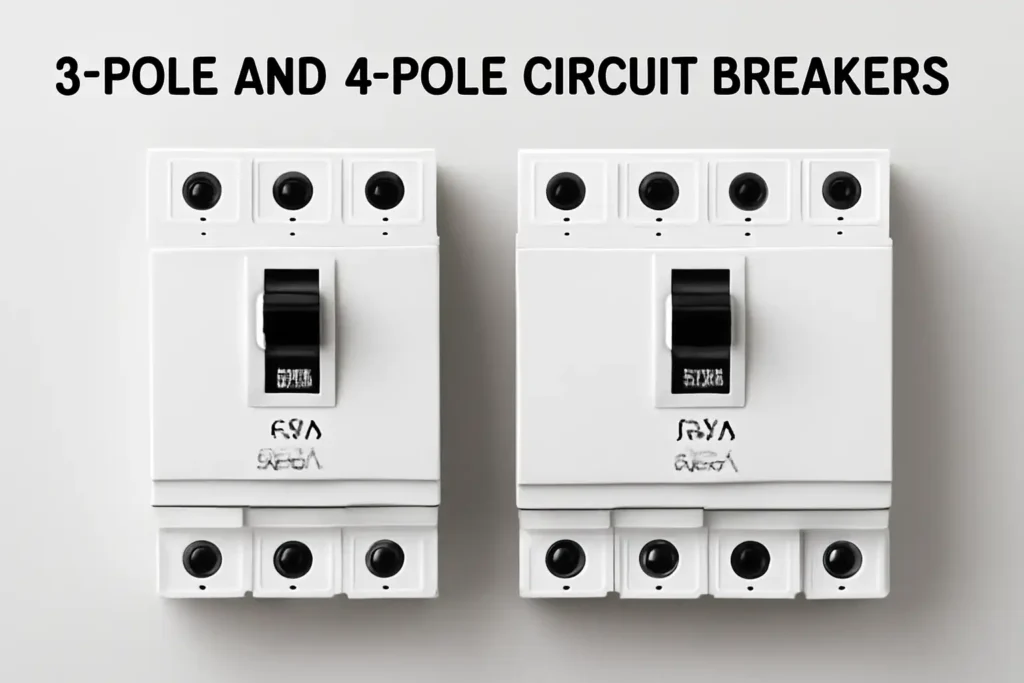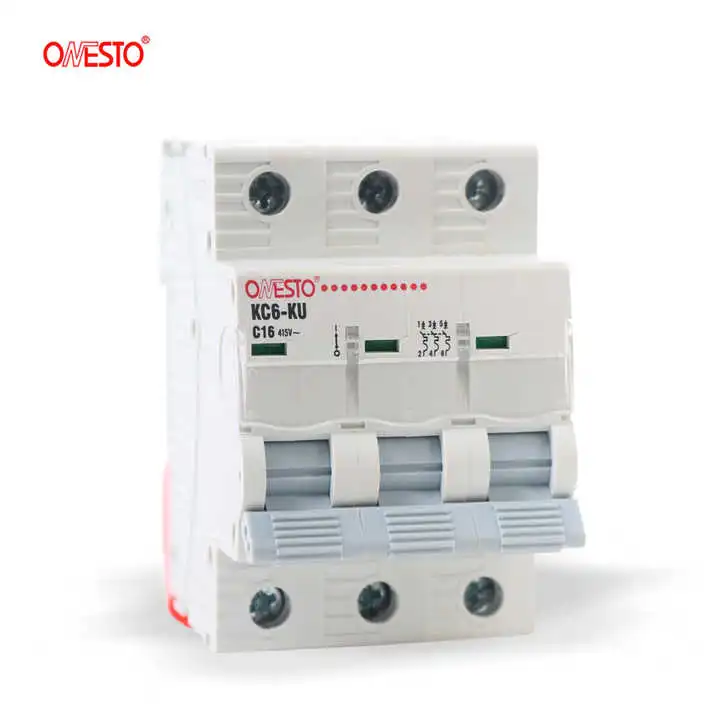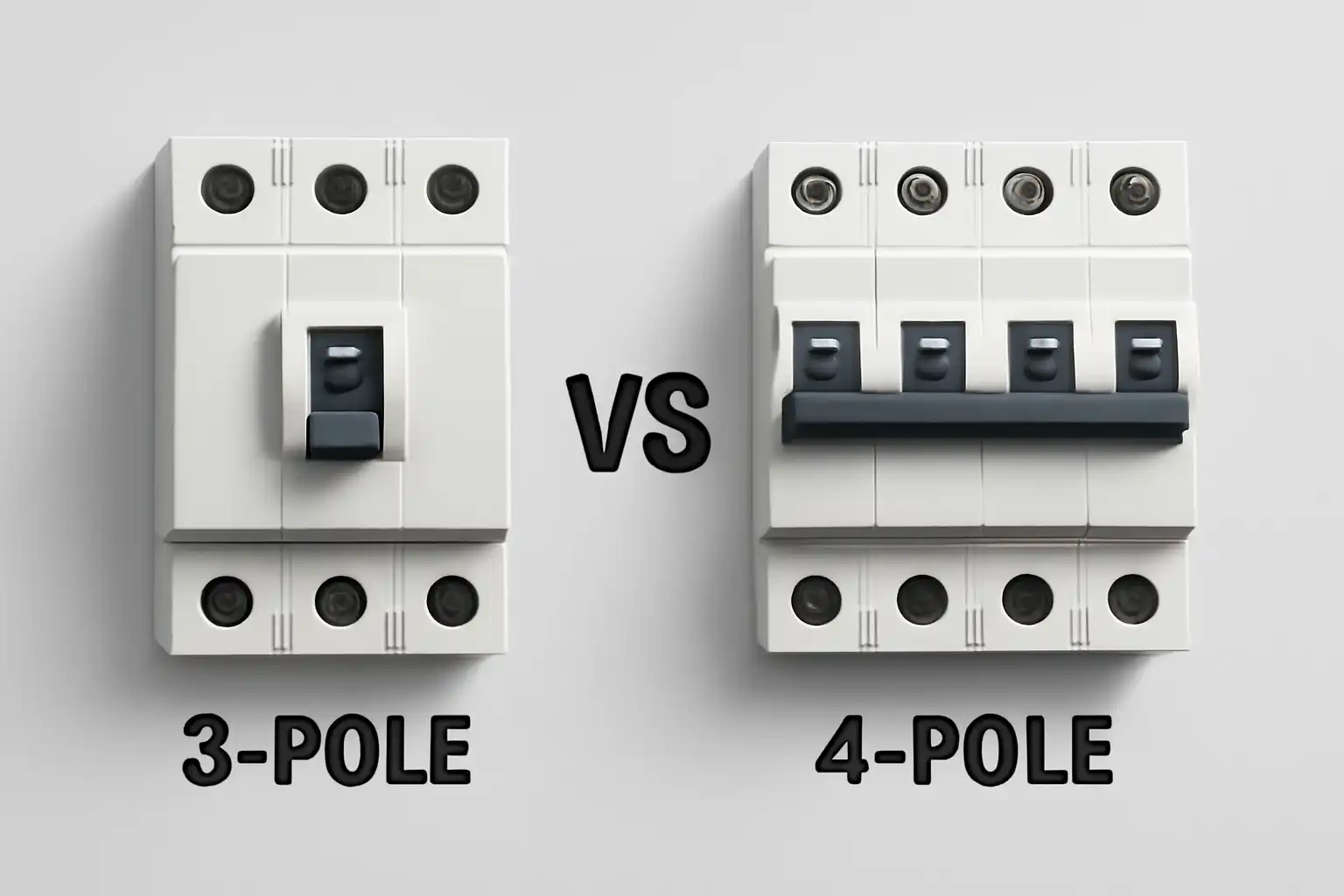When working with electricity, knowing about circuit breakers is important. A 3-pole breaker controls three-phase systems by stopping currents in three wires. But it does not protect the neutral wire. A 4-pole breaker, however, also protects the neutral wire. This is helpful for systems with uneven loads or delicate devices. Picking the right breaker depends on your system’s needs and the load type.
Key Takeaways
- A 3-pole breaker protects three-phase systems but not the neutral wire. Use it for systems without a neutral wire.
- A 4-pole breaker protects the neutral wire too. It works well for systems with uneven loads or delicate devices.
- Pick a 4-pole breaker for places like data centers or solar energy setups. It keeps things safe and reliable.
- Think about your system’s load type and safety needs before choosing a breaker. This helps prevent damage and keeps things running smoothly.
- Always focus on safety features in breakers, especially for tricky or sensitive systems.
Overview of 3-Pole Circuit Breakers
Functionality
A 3-pole circuit breaker keeps three-phase systems safe. It watches and stops currents in three wires. This helps the system work without problems. These breakers are best for setups without a neutral wire. They focus only on the three main wires. They stop overloads and short circuits to avoid damage or danger.
Performance checks show how dependable 3-pole breakers are. They measure things like how fast they open and close. They also check how long arcs last and how quickly faults are stopped. These checks make sure the breaker works fast to reduce risks. Features like wear detection and tracking events keep them working well over time.
Typical Applications
3-pole circuit breakers are used in many places. They are often found in:
- Stopping overloads and short circuits in electrical systems.
- Sharing power across three-phase setups.
- Keeping power safe in factories and big buildings.
- Protecting motors from problems and overloads.
Here’s a table showing common uses:
| Application Type | Description |
|---|---|
| Distribution | Shares electrical power safely. |
| Motor Protection | Stops motor problems and overloads. |
| Electrical Power Supply | Keeps power safe in industrial areas. |
| Power Generation Installations | Used in places that make electricity. |
These breakers help keep three-phase systems steady and safe. Whether in factories or big buildings, they protect your electrical setup reliably.
Overview of 4-Pole Circuit Breakers
Functionality
A 4-pole circuit breaker watches over four wires in a system. These wires include three-phase wires and one neutral wire. It stops problems like overloads or short circuits to avoid harm. Unlike a 3-pole breaker, it also protects the neutral wire. This is important for systems with uneven power use.
Think of it as a safety tool for your system. It keeps all wires, including the neutral, safe from damage. This makes it great for setups where the neutral wire carries extra current. Its design works well for tricky electrical systems and ensures reliability.
Neutral Line Protection
The neutral wire is key in many systems. It balances current and sends electricity back safely. But uneven loads or faults can make the neutral wire carry too much current. This can cause overheating or damage.
A 4-pole breaker solves this by watching the neutral wire and the three-phase wires. If it finds a problem, it shuts off all four wires at once. This keeps your system safe. By protecting the neutral wire, it lowers risks and boosts safety, especially in delicate setups.
Tip: Use a 4-pole breaker for systems with uneven loads or sensitive devices.
Typical Applications
4-pole breakers are used where neutral wire safety matters most. Common uses include:
- Unbalanced Load Systems: Keeps systems safe when power isn’t evenly spread.
- Data Centers: Protects devices that need steady electricity.
- Commercial Buildings: Handles setups with mixed power needs.
- Renewable Energy Systems: Works with solar or wind systems that change power levels.
Here’s a table showing why 4-pole breakers are useful:
| Application Type | Why Choose a 4-Pole Breaker? |
|---|---|
| Unbalanced Load Systems | Stops damage from unexpected currents in neutral wire. |
| Data Centers | Keeps sensitive equipment running smoothly. |
| Commercial Buildings | Manages mixed power demands safely. |
| Renewable Energy Systems | Handles changing power outputs effectively. |
These breakers offer full protection, making them dependable for complex systems.
Key Differences Between 3-Pole and 4-Pole Circuit Breakers
Design
The way a circuit breaker is built affects its job. A 3-pole circuit breaker has three terminals for three-phase wires. It protects these wires from overloads and short circuits. This simple design works well for systems without a neutral wire.
A 4-pole circuit breaker adds one more terminal for the neutral wire. This lets it watch and protect the neutral wire along with the three-phase wires. It is bigger and more complex but offers better safety. This makes it useful for systems with uneven loads or delicate devices.
Note: Use a 4-pole breaker if your system has a neutral wire. It gives full protection.
Functionality
These circuit breakers work differently based on their purpose. A 3-pole breaker stops current in three-phase wires during problems. It’s good for systems where the neutral wire isn’t needed.
A 4-pole breaker does more. It watches the neutral wire and shuts off all four wires during faults. This is important for systems with uneven power use. For example, in setups with tricky loads, the neutral wire might carry too much current. A 4-pole breaker stops overheating and damage by fixing this issue.
Systems with sensitive devices or changing loads need 4-pole breakers. They protect the neutral wire, making them very reliable.
Use Cases
Choosing between a 3-pole or 4-pole breaker depends on your system. Here’s how they are used:
- 3-Pole Circuit Breakers:
- Best for systems with balanced three-phase loads.
- Often used in factories and power plants.
- Protects motors in setups without a neutral wire.
- 4-Pole Circuit Breakers:
- Great for buildings with uneven power use.
- Needed in homes with medical devices like ventilators.
- Works well in solar or wind energy systems.
Examples show these differences clearly:
- In buildings, 4-pole breakers stop unbalanced currents and protect the neutral wire.
- In homes, 4-pole breakers keep medical devices safe by stopping shocks through the neutral wire.
Tip: Use a 4-pole breaker for systems with sensitive devices or uneven loads. It ensures safety and reliability.
Choosing the Right Circuit Breaker
Factors to Consider
Picking the right circuit breaker means checking important details. These help the breaker work well with your system.
- Electrical Characteristics: Find out if your system uses AC or DC power. Check the voltage to make sure it matches the breaker.
- Environmental Conditions: Think about the temperature and where the breaker will go. Outdoor setups may need breakers that handle bad weather.
- Load Characteristics: Know what devices your system uses, like motors or lights. Each has different power needs.
- Installation Requirements: Look at the space and weight limits for the breaker. Make sure it fits and allows easy cable access.
- Maintenance Accessibility: Consider how often the breaker needs fixing. Pick one with easy-to-find parts and helpful features.
- Cost Considerations: Compare the price, setup costs, and long-term expenses. Think about reliability and repair costs too.
Here’s a table showing these factors:
| Factor | Description |
|---|---|
| Electrical Characteristics | AC or DC, Voltage of the installation for which the CB is intended. |
| Environmental Conditions | Ambient temperature, location (kiosk or switchboard), and climatic conditions. |
| Load Characteristics | Types of loads such as motors, fluorescent lighting, LED lighting, and transformers. |
| Installation Requirements | Space, weight, cable entry options, and accessibility for maintenance. |
| Maintenance Accessibility | Frequency of maintenance, ease of access, availability of spare parts, and self-diagnostic capabilities. |
| Cost Considerations | Initial equipment cost, installation costs, operational costs, maintenance costs, and reliability costs. |
Tip: Match the breaker to your system’s power and location for best results.
Load Type and System Requirements
Knowing your system’s load type helps you pick the right breaker. Different devices need specific breaker features.
- Resistive Loads: Homes with lights and appliances use Type B breakers. These handle low power surges well.
- Inductive Loads: Businesses with pumps and motors need Type C breakers. These manage medium power surges.
- Large Inductive Loads: Factories with heavy machines use Type D breakers. These handle big power surges.
- Sensitive Devices: Systems with IT or medical devices need Type Z breakers. These protect against small power surges.
Here’s a table comparing breaker types:
| Type | Tripping Current | Applications | Characteristics |
|---|---|---|---|
| Type B | Low (1-5x rated) | Residential, light industrial | Ideal for resistive loads like light fixtures and appliances |
| Type C | Moderate (5-10x rated) | Commercial, industrial | Suitable for small inductive loads like pumps and motors |
| Type D | High (10-15x rated) | Industrial | Handles large inductive loads, ideal for battery charging and medical equipment |
| Type Z | Very Low (2-3x rated) | Sensitive devices | Protects semiconductor-based IT and medical equipment from low current surges |
Note: Pick a breaker type based on your system’s devices to avoid damage.
Safety Considerations
Safety is the most important part of choosing a circuit breaker. The right breaker keeps your system and people safe.
A 4-pole circuit breaker gives extra safety for tricky systems. In homes, it protects the neutral wire and stops shocks during problems. This keeps your family safe.
In factories, the 4-pole breaker shuts off all wires during faults. This lowers the chance of fires and serious damage. It’s very useful in risky setups.
Alert: Always choose breakers with strong safety features for sensitive systems or dangerous places.
Picking the right circuit breaker keeps your system safe and efficient. A 3-pole circuit breaker is good for three-phase setups without neutral wire safety. A 4-pole circuit breaker adds protection for uneven loads or delicate devices.
Check what your system needs before deciding. Think about the load type and how much safety is required. This helps you choose the breaker that fits your setup and avoids problems.
Tip: Focus on safety and reliability when selecting a circuit breaker.
FAQ
What is the main difference between 3-pole and 4-pole circuit breakers?
A 3-pole breaker protects three wires in a system. A 4-pole breaker also protects the neutral wire. This makes it better for systems with uneven loads or sensitive devices.
What type of system needs a 4-pole circuit breaker?
Use a 4-pole breaker for systems with uneven power or neutral wire use. Examples include data centers, solar setups, and buildings with delicate equipment.
Can you use a 3-pole breaker in a system with a neutral wire?
No, 3-pole breakers don’t protect the neutral wire. If your system has a neutral wire, pick a 4-pole breaker for full safety.
What factors should you consider when choosing a circuit breaker?
Think about your system’s load type, voltage, and safety needs. Match the breaker to your setup to avoid problems and keep it working well.
Why is neutral line protection important?
The neutral wire balances power and stops overheating. Without protection, it can get damaged and cause risks. A 4-pole breaker keeps the neutral wire safe during issues.
The following information may be of interest to you
5 Core Secrets for Purchasing 3-Pole Circuit Breakers
Can a three pole circuit breaker be used for two pole circuits






